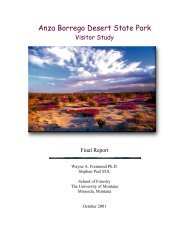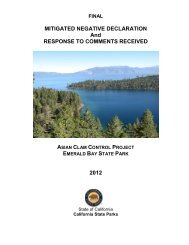Draft EIS/EIR for the San Luis Reservoir SRA Resource ...
Draft EIS/EIR for the San Luis Reservoir SRA Resource ...
Draft EIS/EIR for the San Luis Reservoir SRA Resource ...
You also want an ePaper? Increase the reach of your titles
YUMPU automatically turns print PDFs into web optimized ePapers that Google loves.
5. Environmental Analysis<br />
Goal RES-H1 Goal RES-H1 and associated guidelines require that ef<strong>for</strong>ts be<br />
made to minimize impacts on cultural resources when future facilities are sited.<br />
With proper precautions, proposed facilities could be sited and constructed in a<br />
way that would not result in substantial impacts on existing known and<br />
unrecorded resources.<br />
Mitigation CUL1 In addition to <strong>the</strong> Plan goals and guidelines, <strong>the</strong> following<br />
measures would be considered and applied as necessary <strong>for</strong> all of <strong>the</strong> action<br />
alternatives during project construction to avoid or minimize adverse impacts.<br />
• Prior to any specific proposed undertaking that would have <strong>the</strong> potential to<br />
affect cultural resources, a cultural resources inventory will be conducted<br />
<strong>for</strong> <strong>the</strong> areas of potential effects by qualified personnel who meet <strong>the</strong><br />
Secretary of <strong>the</strong> Interior’s professional qualification standards (36 CFR<br />
Part 61). This ef<strong>for</strong>t may be in conjunction with consultation with<br />
members of <strong>the</strong> local Native American community and consultation with<br />
o<strong>the</strong>r interested members of <strong>the</strong> public as appropriate. This inventory<br />
would identify <strong>the</strong> known cultural resources that would be affected by a<br />
proposed project. The cultural resources would <strong>the</strong>n be evaluated <strong>for</strong> <strong>the</strong>ir<br />
eligibility <strong>for</strong> <strong>the</strong> NRHP or CRHR. If <strong>the</strong> affected resource is not<br />
significant (does not qualify as an historic property, historic resource, or<br />
unique archaeological resource), <strong>the</strong>n no mitigation would be required and<br />
<strong>the</strong> impact would be considered minor. If <strong>the</strong> affected resource qualifies as<br />
an historic property, historic resource, or unique archaeological resource<br />
and <strong>the</strong> impacts can be mitigated (treated) through <strong>the</strong> Section 106 process<br />
and CEQA, <strong>the</strong>re would be no residual impact (i.e., considered less than<br />
significant under CEQA). If <strong>the</strong> resource cannot be mitigated through <strong>the</strong><br />
Section 106 process, Reclamation may still be able to conclude <strong>the</strong> Section<br />
106 Process as described in 36 CFR Part 800.7 (Failure to resolve adverse<br />
effects) of <strong>the</strong> Section 106 implementing regulations. Reclamation may<br />
also elect to reconsider <strong>the</strong> action to <strong>the</strong> affected resource, seek measures<br />
to resolve adverse impacts outside <strong>the</strong> Section 106 process, or implement<br />
<strong>the</strong> project upon conclusion of <strong>the</strong> Section 106 process.<br />
• In <strong>the</strong> event a significant cultural resource, as defined by <strong>the</strong> NRHP and<br />
CRHR criteria, is identified and has <strong>the</strong> potential to be adversely affected,<br />
appropriate measures will be taken to avoid <strong>the</strong> resource. In <strong>the</strong> event <strong>the</strong><br />
resource cannot be avoided, measures such as data recovery, fur<strong>the</strong>r study,<br />
enhanced recordation, interpretation, physical protection, or some<br />
combination of <strong>the</strong>se measures will be implemented. With implementation<br />
of <strong>the</strong>se measures, residual minor impacts would likely result in a finding<br />
of no adverse effect or no significant impact.<br />
Mitigation CUL2 Prescribed burn areas and areas where weed eradication and<br />
pest management would take place shall be monitored and/or surveyed as<br />
appropriate <strong>for</strong> early detection and evaluation, if required, of previously unknown<br />
cultural resources. The cultural resources management plan should be<br />
implemented <strong>for</strong> known cultural resources sites that qualify as historic properties<br />
<strong>San</strong> <strong>Luis</strong> <strong>Reservoir</strong> <strong>SRA</strong> 5-45<br />
<strong>Draft</strong> RMP/GP and <strong>Draft</strong> <strong>EIS</strong>/<strong>EIR</strong>
















